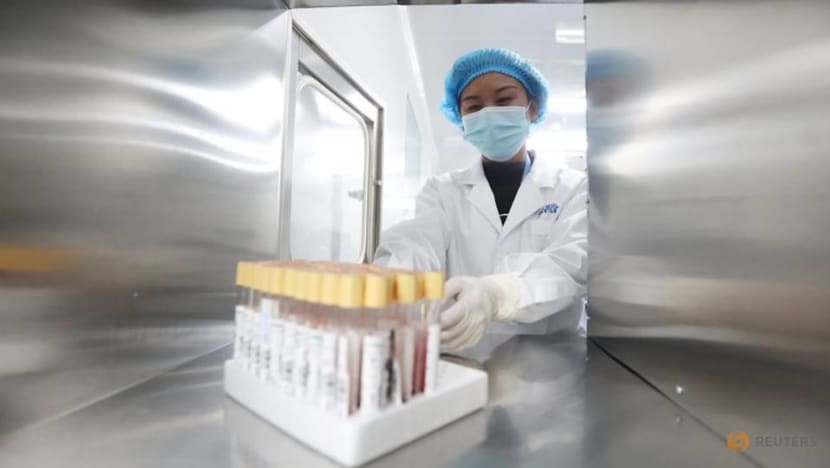commentary Commentary
Commentary: Arts and humanities can set you up for life in post-coronavirus world
The arts and humanities should gain traction in the age of tech and coronavirus, say Linda Lim, Gunalan Nadarajan and Jessie Yang.

(Photo: Unsplash/Vasily Koloda)
ANN ARBOR, Michigan: The COVID-19 pandemic has changed many things about the world and our lives in it.
As more places reopen from shutdowns, preparing for the post-pandemic future has taken on new urgency, not least for those concerned about education and employment prospects in a reshaped world economy that may take years to recover from the deepest recession in nearly a century.
It might seem obvious Singaporeans should increase our longstanding focus on STEM (Science, Technology, Engineering, Mathematics), given the pandemic’s origins and solutions in these fields.
Yet it is the involvement of humanities scholars that is being credited with enabling the German government to reopen its economy.
Philosophers, historians, theologians, jurists and pedagogical experts outnumbered scientists and medical specialists on an advisory group convened to decide reopening issues relating to ethics, law, human and social behavior, political power and the role of government in balancing the needs of health, the environment and the economy.
This has not happened in the United States, which has not been notably successful in combating the pandemic.
Yet here the arts and humanities are becoming increasingly important to technological advance, business, tech employment, and STEM education itself.
As Microsoft President Brad Smith, and Executive Vice President of Artificial Intelligence (AI) and Research Harry Shum wrote in 2018: "Skilling up for an AI-powered world involves more than science, technology, engineering, and math. As computers behave more like humans, the social sciences and humanities will become even more important.”
“Languages, art, history, economics, ethics, philosophy, psychology and human development courses can teach critical, philosophical and ethics-based skills that will be instrumental in the development and management of AI solutions."

HUMANS AT THE HEART OF A WORLD OF ADVANCED TECHNOLOGY
COVID-19 will accelerate trends toward digitalisation, automation and AI. We already know that in the future workspace, humans and machines will work together as a team, collaborating intelligently to enhance each other’s complementary strengths.
Humans are good at solving problems requiring adaptability, creativity, and social skills. Machines can analyse large amounts of data at a high speed impossible for humans, and can outperform humans on well-defined questions — for example, enabling much faster analysis of the COVID-19 virus and development of treatments for it.
For the human-machine partnership to function optimally, we should understand how the two agents can most effectively augment each other, and how to redesign the interaction process to support this.
READ: Commentary: Alibaba makes a whopping US$28 billion bet on its next breakthrough act
READ: Commentary: This COVID-19 outbreak, corporate leaders should acknowledge they don’t have all the answers
Take automated vehicles, which have huge economic and safety benefits. According to the Society of Automotive Engineers (SAE), vehicle automation ranges from level 0 (no automation) to level 5 (full automation).
Almost all automated vehicles on the road are at level 2 (partial automation), where the vehicle can control steering, accelerating and decelerating but the human driver is responsible for monitoring the environment and retaking control from the automated vehicle if it reaches its performance limit.
At level 3 (conditional automation), the vehicle will have “environmental detection” capabilities, but still require human override in corner cases. In level 4 (high automation), the vehicle can perform all driving functions under certain conditions and in certain areas.
For other conditions and areas, humans still need to drive, which hinges on the design of novel human-machine interfaces.
Can we expect a human driver who has been watching movies or texting friends in a level 3 automated vehicle to quickly move attention to the driving task, comprehend what is happening in the environment, and perform an appropriate maneuver, all within seconds?
How do we design better interfaces to help the human driver negotiate takeover transitions? To answer such questions, we need to better understand humans, their cognitive, physical and emotional capabilities, for which the arts and humanities are necessary.
ECONOMICS AND BUSINESS
According to Northwestern University professors Gary Saul Morson and Morton Schapiro, economic models fail when they lack human understanding, specifically culture, stories and ethical considerations.

They recommend studying literature, since novels help develop empathy by requiring readers to see the world as their stories’ characters do.
Nobel prize-winning economist Robert Shiller also argues that popular stories which affect individual and collective economic behavior are what move markets.
For example, fear of "technological unemployment" -- a narrative that robots were taking people's jobs — created panic which exacerbated the stock market plunge during the Great Depression of the 1930s.
On the personal career front, top executives interviewed by the World Economic Forum in 2016 identified ten essential skills for business success: complex problem solving, critical thinking, creativity, people management, coordinating with others, emotional intelligence, judgment and decision making, service orientation, negotiation skills and cognitive flexibility.
READ: Commentary: Humanities at the heart of a holistic education in a tech-driven world
READ: A liberal arts education in Singapore and the usefulness of ‘useless’ knowledge, a commentary
Academic commentator Richard Greenwald concluded that these skills are rooted in liberal arts education, explaining that so many Fortune 500 and tech startup CEOs have liberal arts degrees because “the liberal arts alone provides the basis for leadership, lifelong learning, and a meaningful life.”
The late Steve Jobs famously said at a 2011 Apple product launch: “It’s in Apple’s DNA that technology alone is not enough — it’s technology married with liberal arts, married with the humanities, that yields us the results that make our heart sing.”
Along the same lines, a 2018 Linked-In survey found that 57 per cent of leaders said that soft skills like leadership, communication and collaboration were more important than hard skills.
A 2015 British Council study in 30 countries found that 55 per cent of the 1,700 corporate, non-profit and government leaders surveyed had either a social sciences or humanities bachelor’s degree, more common among younger leaders (aged under 45).

Other US labour market surveys show liberal arts graduates’ employment in STEM fields in the US has grown much faster than that of computer science and engineering graduates; and that liberal arts graduates make up a larger percentage of today’s tech workforce than technical graduates do.
This is because STEM companies need employees who can understand and communicate with diverse users and partners, and contribute to the creative and ethical processes of developing technology for the market.
Most jobs in STEM fields are non-STEM, from sales and marketing, to people and product management, training and support services. Among humanities graduates, the biggest group go on to management positions (15 per cent), followed by office and administrative positions (14 per cent), sales (13 per cent), education (12 per cent), business and finance (10 per cent).
READ: Commentary: Science goes viral, thanks to COVID-19. But there are roadblocks along the way
READ: Commentary: COVID-19 could make remote working a permanent feature. That has several implications for firms
Rapid technological change and increased volatility, uncertainty, complexity and ambiguity mean most people will change jobs, perhaps frequently, during their careers. Liberal arts education helps provide the broad disciplinary preparation, flexibility and adaptability, critical and imaginative thinking, that will facilitate the constant reskilling required.
THE IMPLICATIONS FOR SINGAPORE
Singapore comes second only to the US in the Swiss business school IMD’s 2019 world digital competitiveness ranking.
Yet without developing greater competencies in the arts and humanities, we risk losing out as higher levels and ever greater portions of global tech value chains are increasingly accounted for by activities and skills derived from them, and “hard” skills become obsolete or more readily automated.
A 2019 Brookings Institution study forecasts that computer programmers, financial advisers, and certain types of engineers and software developers are among those whose jobs are most likely to be displaced by AI. More of the jobs which remain will require more durable “soft” skills, which engagement with the arts and humanities can develop.

But the arts and humanities are also desirable for their own sake, both as expressions of our humanity, and as a valuable consumption good.
The COVID-19 lockdown experience saw an explosion of arts activity online, with choirs, orchestras, bands, dance concerts, play readings, art lessons and the like spontaneously self-organizing, even across national boundaries.
“Streaming wars” among “hard” tech companies like Amazon and Apple as they venture into the entertainment space, chasing an “old-line” company like Disney, illustrate the growing importance of arts content in the world of tech, and of tech in the world of the arts, something already familiar to millions of video gamers the world over.
READ: Commentary: Reading can be a useful escape from the circuit breaker in more ways than one
LISTEN: COVID-19: Aviation and flying never ever the same again
The arts and humanities are also necessary for understanding consumer behavior, since the consumer is a human being evolving in particular historical, sociological, psychological and cultural contexts that they study and express.
It is impossible to serve her without understanding these contexts, for example through “design thinking”, increasingly viewed as a core business capability.
Machine learning and data analytics can yield patterns of consumer behavior, but interpreting them relies on insights gleaned from the arts and humanities. Thus employers’ demand for such graduates has increased as developments in data analytics and AI progress.
For Singapore, the unique value we can deliver to the nearly all-encompassing world of global tech is our understanding of people and societies in our own regional neighborhood. For this, we will need to expand our competencies beyond STEM and the Western world of digitalisation to include the humanities, and the visual, performing and literary arts of our Southeast Asian neighbors.
In education, the arts and humanities provide a means of engaging students with STEM disciplines and with business. There are STEAM (A for Arts) programmes in many American K-12 schools, and in Singapore.

The professional theater company Shakespeare-in-Detroit collaborates with Detroit Public Schools educators to teach “the Science of lighting production, the Technology of sound design, the Engineering or construction of a form or costume, the Art of classical performance, and the Mathematics of building a set … along with development of soft skills such as communication and confidence” and increased literary competencies.
Oxford University’s Said Business School uses the performing arts to teach business leadership in its MBA programme.
The US’ National Academies of Sciences, Engineering and Medicine 2018 report on The Integration of the Humanities and Arts with the Sciences, Engineering and Medicine in Higher Education concluded that integrating arts and humanities with STEMM education (the second M standing for Medicine) is strongly associated with improved written and oral communications skills, teamwork skills, ethical decision making, critical thinking and deeper learning, strong content mastery, general engagement and enjoyment of learning, empathy and resilience, ability to apply knowledge in real-world settings and science literacy.
All of these have labour market, job performance and broader economic payoffs.
READ: Commentary: How to sabotage your child’s future – five dangerous notions about life, careers and education
READ: Commentary: Singaporeans more adaptable than they give themselves credit for
One example is the University of Michigan’s Integrated Product Development course jointly taught by an art and design, and a business professor, in which students from engineering, design and business explore together the creative, technological and business-related questions involved in developing new products from ideation and prototyping to production and bringing to market.
Finally, arts practitioners are often at the frontier of unearthing and examining social issues.
The COVID-19 crisis among foreign workers reminds us of the Singapore arts community’s proactive role in highlighting and creating empathy for their dilemma in our midst, through numerous plays, poetry, stories, photography exhibitions, and films which have won showings and awards at international festivals, like Ilo Ilo (Cannes, 2013), I Dream of Singapore (Singapore, 2019; Berlinale, 2020) and A Land Imagined (Locarno, 2018). Heeding their efforts could have pre-empted our current crisis.
To advance in technology, which requires human engagement, we need to also advance in the arts and humanities. Transition to a post-COVID-19 world more heavily dependent on technology, and more aware of both the shortcomings and potentials of human society under crisis, is a good time to do this.
LISTEN: Disruption 101: How COVID-19 is revolutionising work
BOOKMARK THIS: Our comprehensive coverage of the novel coronavirus and its developments
Download our app or subscribe to our Telegram channel for the latest updates on the coronavirus outbreak: https://cna.asia/telegram
Linda Lim, Gunalan Nadarajan and Jessie Yang are Singaporean professors at the University of Michigan. This is an abridged version of a commentary first published on Academia.SG.

















